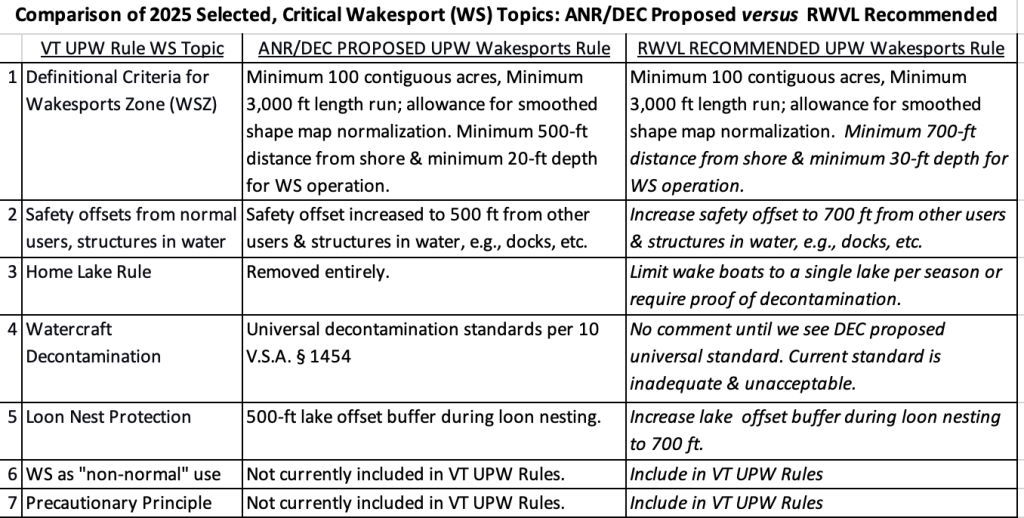Action Requested
Responsible Wakes for Vermont Lakes (RWVL) supports most of the DEC’s proposed statewide UPW Wakesports Rule revisions but urges additional improvements based on new safety and water quality data.
We ask you to:
- Submit your own comments to the DEC supporting the DEC’s rule change proposal while requesting stronger protections (see points below). Your comments need not be lengthy, e.g., 150-300 words. Feel free to modify what you submitted for last year’s 2024 DEC UPW Wakesports Rule or for your December 2024 comments re. individual petitions.
To: ANR.WSMDLakes@vermont.gov
Subject: Wakesports (You must include “Wakesports” in the subject line.)
- Authorize RWVL to include your name in our group comment letter below by emailing permission to: responsiblewakesvt@gmail.com
RWVL’s Group Comment Letter to ANR/DEC
From: Responsible Lakes for Vermont Lakes (RWVL)
Subject: Comments on Proposed Changes to Wakesports Rules
RWVL applauds and strongly endorses much of the DEC’s recently proposed Vermont Use of Pubic Waters (UPW) Wakesports Rule. However, we request that it be strengthened as discussed here.

1. Definitional Criteria for Wakesports Zones
- Length: RWVL supports the required minimum of 3,000 feet for wakesport runs.
- Wake boats need this distance to accelerate, raise/tune waves, allow surfers to stabilize before dropping the rope, surf for ~1 minute, and then decelerate and return to pick up the surfer.
- 3,000 ft run is supported by the Vermont DEC (2023) (Slide 20). This served as the basis for RWVL’s website video, “A Wake Surfing Session,” (bottom video on “Wake Sports” page) along with information included from several supportive wakesports industry instructional materials (Wakesurf Vermont; Reddit, Inc. 2025).
- Acreage: RWVL supports the increase from 50 to 100 contiguous acres, with at least 700 ft from shore and 30 ft depth.
- RWVL recommends a distance from shore of 700 ft based on 1. 2022 SAFL study (p 88); 2. Univ Montreal Study 2014; and 3) RWVL’s 2022 ANR Wakesports Petition (pp 17 & 18) and the DEC staff’s Sept 18, 2023 Memo to Sec. Julie Moore. The staff recommended a 600 ft operating distance (575–600 ft for wave energy/power dissipation, but we strongly believe that an additional 15% distance is needed for future research, per the Precautionary Principle, defined below).
- To accommodate a 700 ft wake reach on each side over 3,000 ft, a lake of ~100 acres is required.
- Depth: RWVL proposes increasing the minimum depth to 30 ft.
- Studies done by Western Colorado University (2020), University of Minnesota (2025), Terra Vigilis (2024)recommend a depth greater than 20 ft to protect lake bottoms.
- A 30 ft depth takes into account the impacts from ever more powerful and heavier wake boats, changing weather patterns, and warmer temperatures.

2. Safety Offsets from Other Users and Structures
- RWVL supports an increase from the current 200 ft but recommends 700 ft.
- Studies show wave dissipation requires >575 ft (energy) and >600 ft (power). 1. 2022 SAFL study ( p 88); 2. Univ Montreal Study 2014; and 3) RWVL’s 2022 ANR Wakesports Petition (pp 17 & 18).
- DEC staff recommended 600 ft in Sept. 2023.
- 700 ft includes additional precautionary distance.
3. Home Lake Rule
- Without a Home Lake Rule we recommend asking wake boat owners to commit to keeping their boats in a single lake per season. Require wake boats visiting a wakesports eligible lake to show proof of decontamination or guide them to local lakes without regulations, such as Lake Champlain or Lake Memphremagog.
- AIS from ballast tanks is a documented threat; mitigation is costly, and eradication often impossible.
- A significant portion of AIS-related expenses, to protect a public good, becomes the responsibility of a small number of municipalities and lake associations.
4. Wake Boat Decontamination
- RWVL supports strict inspection and decontamination of all craft before lake entry.
- RWVL concerns: DEC allows wake boats to enter Vermont waters with closed ballast tanks that cannot meet inspection requirements under 10 V.S.A. § 1454 (Vermont’s Aquatic Nuisance Control Act).
- The Act also requires: “A person operating a vessel shall drain the vessel, trailer, and other equipment of water in a manner to avoid a discharge to the water of the State.” Common wakesport practice—draining ballast tanks before leaving the lake—conflicts with these requirements.
5. Loon Nest Protection
- Per Vermont Center for Ecostudies expert statement on Aug 6, 2025, RWVL supports an increase from the current 300 ft but we recommends 700 ft.
- Loon nests are only 2–8 inches above water; wakes >2 inches can reach 500–1,000 ft. (1. 2022 SAFL study(p 88); 2. Univ Montreal Study 2014; 3) RWVL 2022 ANR Wakesports Petition (pp 17 & 18); 4) E. Hanson 2023. Water clarity is a likely cause of population decline in common loons (Piper et al. 2024).
6. Wakesports Definition – Not a Normal Use
- RWVL recommends amending the UPW Rules to include a statement that wakesports are not a “normal use”(this statement was made by DEC Commissioner Batchelder at the Feb. 15, 2024 LCAR meeting at minute 10:35).
- We also recommend that non-normal uses may require management rules that differ from those that apply to normal uses.
7. Precautionary Principle
- RWVL recommends not only including a description of the Precautionary Principle in UPW Rules but also using it to establish guidelines for all future UPW rulemaking.
- Recommended description for the Precautionary Principle: “When an activity raises threats of harm to human health or the environment, precautionary measures should be taken even if some cause-and-effect relationshipsare not fully established scientifically.”
Sincerely,
Responsible Lakes for Vermont Lakes (RWVL)
Jack Widness
Jim Lengel
Diane Lehder
Tom Ward
Christine Cano
Holly Wall-Bull
RWVL will add your name to this list of those supporting the above recommendations if you send your request to our email address: responsiblewakesvt@gmail.com
